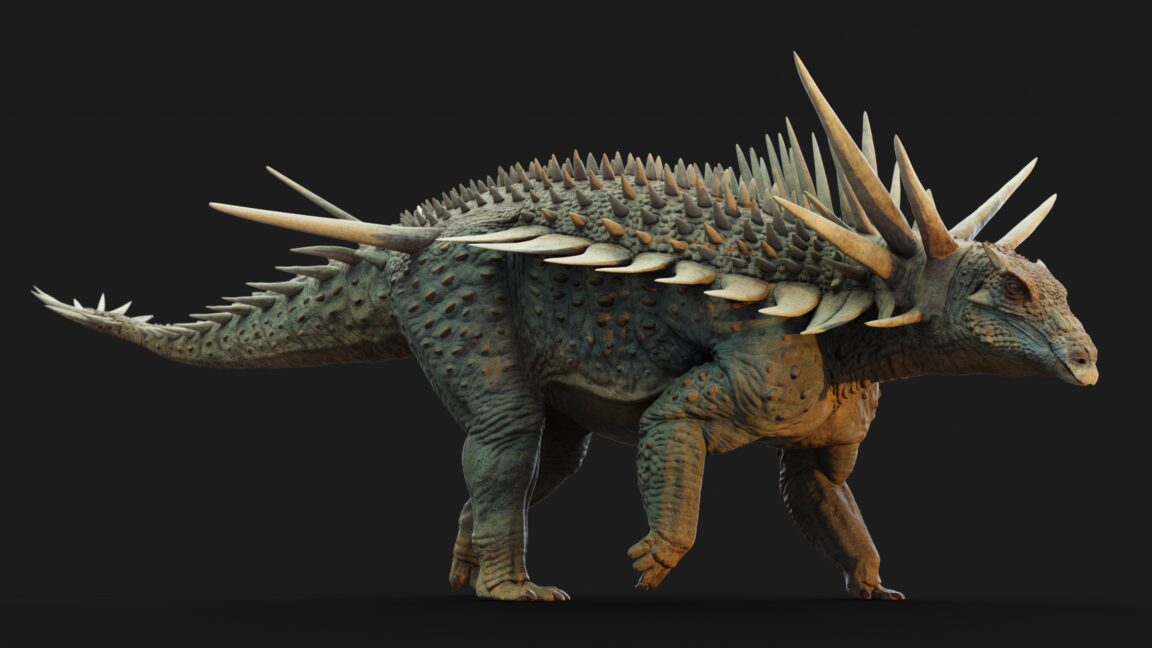Science
New Discoveries Reveal Spicomellus, a Unique Ankylosaur Species

A new dinosaur species, identified as Spicomellus afer, has emerged from fossil discoveries in Morocco, providing significant insights into the evolution of ankylosaurs. This species, a distant relative of well-known armored dinosaurs, showcases an array of features that set it apart from its Cretaceous counterparts. The findings, published in the journal Nature in 2025, enhance our understanding of these prehistoric creatures and their development over millions of years.
Ankylosaurs are characterized by their robust bodies and distinctive armor, which includes bony plates and spikes. Previously, the earliest known ankylosaur was represented only by a fragmentary rib, leaving much to speculation about the group’s origins during the Jurassic period. The newly uncovered fossils of Spicomellus have dramatically changed this perspective, revealing a creature adorned with extensive spikes and a complex arrangement of armor.
Unique Features of Spicomellus
The fossils indicate that Spicomellus afer possessed a remarkable array of features, including meter-long spikes and a bony collar, which were far more elaborate than those seen in later ankylosaurs. Each rib of this dinosaur generated multiple spikes, creating a striking appearance reminiscent of a punk rock aesthetic combined with flamboyant glam influences.
These findings suggest that the armor of early ankylosaurs was more intricate than previously understood. As noted by the research team, “The new specimen reveals extreme dermal armour modifications unlike those of any other vertebrate, extinct or extant.” This complexity raises questions about the evolutionary pressures that led to such elaborate adaptations.
Implications for Evolutionary Understanding
The characteristics of Spicomellus complicate existing theories about the evolution of ankylosaurs. Traditionally, researchers believed that the simpler forms of armor evolved to counter increasingly predatory threats during the Cretaceous. However, the discovery of Spicomellus challenges this notion, suggesting that more elaborate armor may have existed earlier than previously thought.
The researchers speculate that the extravagant features, such as the long spikes, could have served roles in display and combat, particularly for mating purposes. As the study suggests, “Structures with limited obvious functionality and that are energetically expensive to produce tend to be sexually selected and function for display or combat.”
The implications of these findings extend to the evolutionary timeline of ankylosaurs. If Spicomellus indeed shares a lineage with later ankylosaurs, it suggests that certain features, like the tail club, may have been present from the outset rather than developing later in response to environmental pressures. This challenges long-held assumptions about the evolutionary pathways of these armored dinosaurs.
As scientists continue to analyze the fossilized remains and seek additional specimens, the picture of ankylosaur evolution will likely become clearer. The uniqueness of Spicomellus afer not only enriches the narrative of dinosaur history but also highlights the ongoing complexities of evolutionary biology. The study of this remarkable species underscores the need to rethink established ideas and embrace the mysteries that ancient life continues to present.
-

 World5 months ago
World5 months agoSBI Announces QIP Floor Price at ₹811.05 Per Share
-

 Lifestyle5 months ago
Lifestyle5 months agoCept Unveils ₹3.1 Crore Urban Mobility Plan for Sustainable Growth
-

 Science4 months ago
Science4 months agoNew Blood Group Discovered in South Indian Woman at Rotary Centre
-

 World5 months ago
World5 months agoTorrential Rains Cause Flash Flooding in New York and New Jersey
-

 Top Stories5 months ago
Top Stories5 months agoKonkani Cultural Organisation to Host Pearl Jubilee in Abu Dhabi
-

 Sports4 months ago
Sports4 months agoBroad Advocates for Bowling Change Ahead of Final Test Against India
-

 Science5 months ago
Science5 months agoNothing Headphone 1 Review: A Bold Contender in Audio Design
-

 Top Stories5 months ago
Top Stories5 months agoAir India Crash Investigation Highlights Boeing Fuel Switch Concerns
-

 Business5 months ago
Business5 months agoIndian Stock Market Rebounds: Sensex and Nifty Rise After Four-Day Decline
-

 Sports4 months ago
Sports4 months agoCristian Totti Retires at 19: Pressure of Fame Takes Toll
-

 Politics5 months ago
Politics5 months agoAbandoned Doberman Finds New Home After Journey to Prague
-

 Top Stories5 months ago
Top Stories5 months agoPatna Bank Manager Abhishek Varun Found Dead in Well









